In a state where prostitution is legal…
https://twitter.com/cityoflasvegas/status/1288632902381645826?s=21
In a state where prostitution is legal…
https://twitter.com/cityoflasvegas/status/1288632902381645826?s=21
The worldwide (greatly inflated) death count for corona just passed 650K.
For perspective, the WHO reminds you that it is not unusual for the normal, regular, seasonal flu to do the same, without having to destroy the lives of everyone in the world.

Link HERE.
Never, in any flu year, have masks ever been discussed. But now, Fraudci is floating goggles as the next step HERE.
Not to be outdone, the wicked witch of the scarf goes for full face shields. Because “you can decorate them,” you know.
https://twitter.com/theconservador/status/1288823368985313280?s=20
Makes sense, since we are now finding out that the biggest hospitalization/mortality surge is being caused by suicide attempts and drug overdoses. In a society without supernatural faith, despair comes at you really, really fast.
During a Buck Institute Webinar streamed on July 14, Center for Disease Control and Prevention (CDC) Director Robert Redfield promoted the general reopening of schools, highlighting the low coronavirus risk for children without preexisting conditions and the unfortunate spike in suicides and drug overdoses, which Redfield said are “far greater” in number than COVID-linked deaths in the young. HERE
“It’s not risk of school openings versus public health. It’s public health versus public health,” asserted Redfield.
“I’m of the point of view, and I weigh that equation as an individual that has 11 grandchildren that the greater risk is actually to the nation to keep these schools closed,” he continued.
Redfield said that over 7 million children get mental health services from their school, “a lot of people get food and nutrition in schools,” and added that schools are vital “in terms of mandatory reporting sexual and child abuse.”
“Obviously, the socialization is important,” he said.
Obvious, yes. So obvious that this problem was already laid out in early May, and in fact much early than that, in terms of the broader dynamic across the broader population:
By Andrew Glen, Ph.D. and James D. Agresti
May 4, 2020
Medical studies show that excessive stress and anxiety are among the most debilitating and deadly of all health hazards in the world. Beyond their obvious effects like suicide and substance abuse—these mental stressors are strongly related to and may trigger and inflame a host of ailments like high blood pressure, digestive disorders, heart conditions, infectious diseases, cancer, and pregnancy complications.
Based on a broad array of scientific data, Just Facts has computed that the anxiety created by reactions to Covid-19—such as stay-at-home orders, business shutdowns, media exaggerations, and legitimate concerns about the virus—will destroy at least seven times more years of human life than can possibly be saved by lockdowns to control the spread of the disease. This figure is a bare minimum, and the actual one is likely more than 90 times greater.
This study was reviewed by Joseph P. Damore, Jr., M.D., who concluded: “This research is engaging and thoroughly answers the question about the cure being worse than the disease.” Dr. Damore is a certified diplomate with the American Board of Psychiatry and Neurology, an assistant professor of psychiatry at the Weill Medical College of Cornell University, an assistant attending psychiatrist at New York Presbyterian Hospital, and an adjunct professor in the Department of Behavioral Sciences and Leadership at the U.S. Military Academy.
Scientific surveys of U.S. residents have found that the mental health of about one-third to one-half of all adults has been substantially compromised by reactions to the Covid-19 pandemic. Examples include the following:
Contributors to these mental health impacts include but are not limited to:
Among all of the figures above, the lowest nationwide measure of people who have incurred psychological harm from reactions to Covid-19 is the 19% of adults in the late-March Kaiser Family Foundation survey who reported a “major impact” on their mental health. This survey included 1,226 respondents and has a margin of sampling error for this result of ± 2.2 percentage points with 95% confidence.
Therefore, at least 16.8% of 255,200,373 adults in the United States—or 42,873,663 people—have suffered major mental harm from responses to Covid-19. This figure forms the first key basis of this study.
Medical journals are rich with studies that attempt to measure the lethality of stress, anxiety, depression, and other psychological conditions. Determining this is very difficult because association does not prove causation, and unmeasured factors could be at play.
For example, a 2011 meta-analysis in the journal Social Science & Medicine about mortality, “psychosocial stress,” and job losses finds that “unemployment is associated with a substantially increased risk of death among broad segments of the population,” but there are conflicting theories as to why this is so. One is that “unemployment causes adverse changes in health behaviors, which in turn lead to deterioration of health.” Put simply, unemployment causes bad health. The other theory is that bad health causes unemployment. Both of these theories may be true, and factors that are not measured in the studies could be causing both unemployment and bad health. Thus, it is very difficult to isolate these variables and determine which is causing the others and to what degree.
While trying to address such uncertainty, the meta-analysis examined “235 mortality risk estimates from 42 studies” and found that “unemployment is associated with a 63% higher risk of mortality in studies controlling for covariates.”
Regardless of whether job losses from Covid-19 lockdowns are brief or sustained, the study found that the death correlation “is significant in both the short and long term,” lending “some support to the hypothesis and previous findings that both the stress and the negative lifestyle effects associated with the onset of unemployment tend to persist even after a person has regained a job.”
Also of relevance to current job losses, the study indicates that added unemployment benefits, like those recently passed into federal law, are unlikely to mitigate the deadliness of job losses. This is because the meta-analysis found that the associations between unemployment and death in Scandinavia and the U.S. are not significantly different, even though the Scandinavian nations offer more generous welfare benefits. Thus, the authors conclude that “these national-level policy differences may not have much of an effect on the rate of mortality following unemployment.”
A broad range of other studies have similar implications for anxiety-related deaths wrought by reactions to Covid-19:
Among all of the results above, the smallest risk of increased death is 20% in the 2012 meta-analysis. This has a margin of error from 13% to 27% with 95% confidence. The lower limit of 13% translates to an average of about 1.3 years of lost life per person.
Corroborating that figure, 22 of the studies in the 2015 meta-analysis included estimates for the average years of life lost by each person with a mental disorder. These “ranged from 1.4 to 32 years, with a median of 10.1 years.” None of these studies were for anxiety, but the low-end figure of 1.4 years provides additional evidence that those who suffer serious mental repercussions from responses to Covid-19 will lose an average of more than a year of life.
Therefore, the figure of 1.3 years of lost life is a bare minimum and forms the second key basis of this study. This varies widely by person and could be:
Read the rest HERE.
And yes, they are murderers. Suicides and overdoses abounding, not to mention soaring cases of domestic abuse. Children affected more than most. MURDERERS.
PHILADELPHIA (WPVI) — Philadelphia health officials said Tuesday they have postponed the start of indoor dining in the city to no earlier than September 1. The previous date was August 1. HERE
The news comes as Health Commissioner Dr. Thomas Farley announced 142 additional confirmed cases of COVID-19 in Philadelphia. That brings the number of confirmed cases to 29,945.
The city reported no new deaths on Tuesday, but Farley said the city is in its second wave. (Deaths are at Zero, positive tests are below 5%, and hospitalizations are about ten per day… review the charts below and point me to the “second wave.” This is nothing short of the raping of a once great city.)
“We are recommending people not participate in gatherings of any size,” Farely said. “And when you are around your relatives, you should wear a mask.”
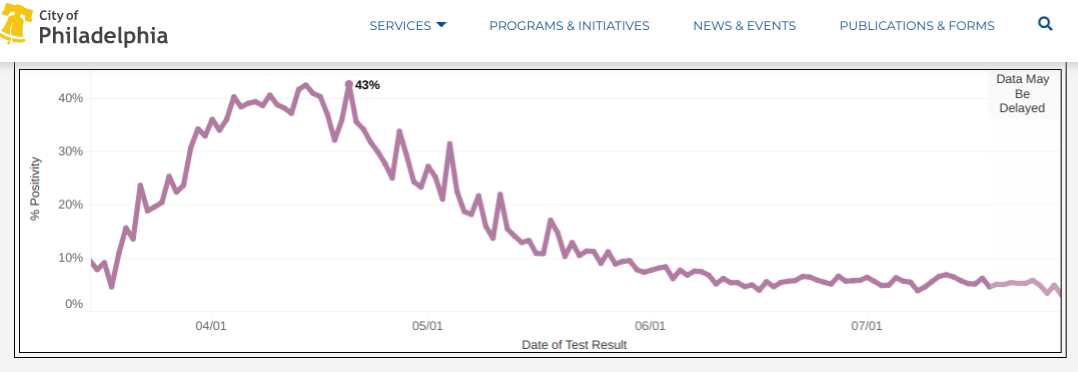

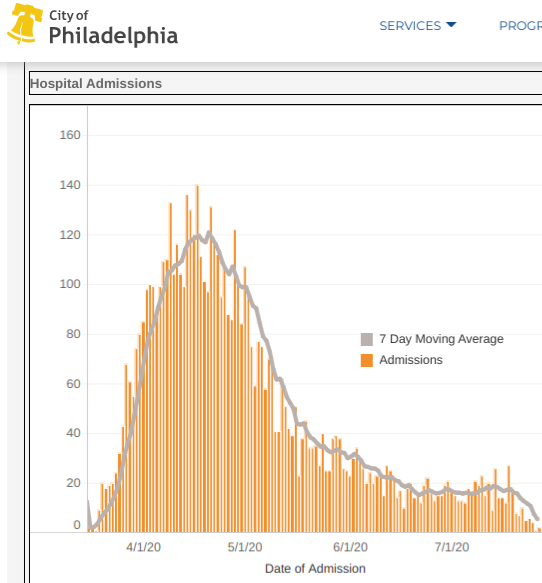
Data current as of 28 July at phila.gov
I’ve never seen anything censored so quickly, and so completely. They had to stop it, because Breitbart alone had gotten 17 million views with it, in less than an hour. In addition, both Facebook and Twitter are inserting counterclaims into the feeds of users who viewed the video on those platforms. This is happening, folks. Video HERE.
Facebook has removed a video posted by Breitbart News earlier today, which was the top-performing Facebook post in the world Monday afternoon, of a press conference in D.C. held by the group America’s Frontline Doctors and organized and sponsored by the Tea Party Patriots. The press conference featured Rep. Ralph Norman (R-SC) and frontline doctors sharing their views and opinions on coronavirus and the medical response to the pandemic. YouTube (which is owned by Google) and Twitter subsequently removed footage of the press conference as well.
I ran into Jerry Nadler in DC and asked him to disavow the Antifa violence/rioting in Portland.
His response?
“THATS A MYTH” pic.twitter.com/veImyE2rju
— Essential Fleccas 🇺🇸 (@fleccas) July 27, 2020
Umm…
Rioters carrying shields rush back to the Portland federal courthouse after law enforcement return inside. Rioters cheer and celebrate, claiming it to be a battle victory. #PortlandRiots #antifa pic.twitter.com/UORcZiuOBW
— Andy Ngô 🏳️🌈 (@MrAndyNgo) July 22, 2020
Antifa rioters are throwing Molotov cocktails toward federal officers at the courthouse. Earlier in the day, police found a cache of ready-made incendiary devices and fully loaded magazines. Video by @livesmattershow. #PortlandRiots pic.twitter.com/KFPyahZ8Er
— Andy Ngô 🏳️🌈 (@MrAndyNgo) July 27, 2020
Activists threw smoke grenades and fireworks to cover their advance. The protest crowd has retaken Lownsdale Park Square. #PortlandProtest #PDXprotests #BlackLivesMatter pic.twitter.com/ULp1PRuyTR
— Justin Yau (@PDocumentarians) July 22, 2020
A federal officer is hit in the face by a projectile from rioters. Far-left accounts and antifa have been celebrating this video. #PortlandRiots pic.twitter.com/WTojfVoae6
— Andy Ngô 🏳️🌈 (@MrAndyNgo) July 26, 2020
Antifa rioters successfully broke down the barrier protecting the federal courthouse. They ignored dozens of orders to stop. Video by @livesmattershow #PortlandRiots #antifa pic.twitter.com/5MkvdMJUAO
— Andy Ngô 🏳️🌈 (@MrAndyNgo) July 26, 2020
“Burn every pig”
“Burn it to the ground”
“We got the guillotine”
“Revolution”They state clearly what their goals are. #antifa #PortlandRiots pic.twitter.com/9SyrOppsPy
— Andy Ngô 🏳️🌈 (@MrAndyNgo) July 27, 2020
Graffiti on the county courthouse in Portland: “Until the police & ICE are abolished, we will burn this city down piece by piece.” #PortlandRiots #antifa pic.twitter.com/riUQ2cK56m
— Andy Ngô 🏳️🌈 (@MrAndyNgo) July 26, 2020
They hate you, and want you dead. MSM is the propaganda arm of antifa. It was merely the intensification of a peaceful demonstration, you bigot.
https://twitter.com/abc/status/1287396378407243777?s=21
This chart only gets updated on Sundays, so it wasn’t included in yesterday’s post.
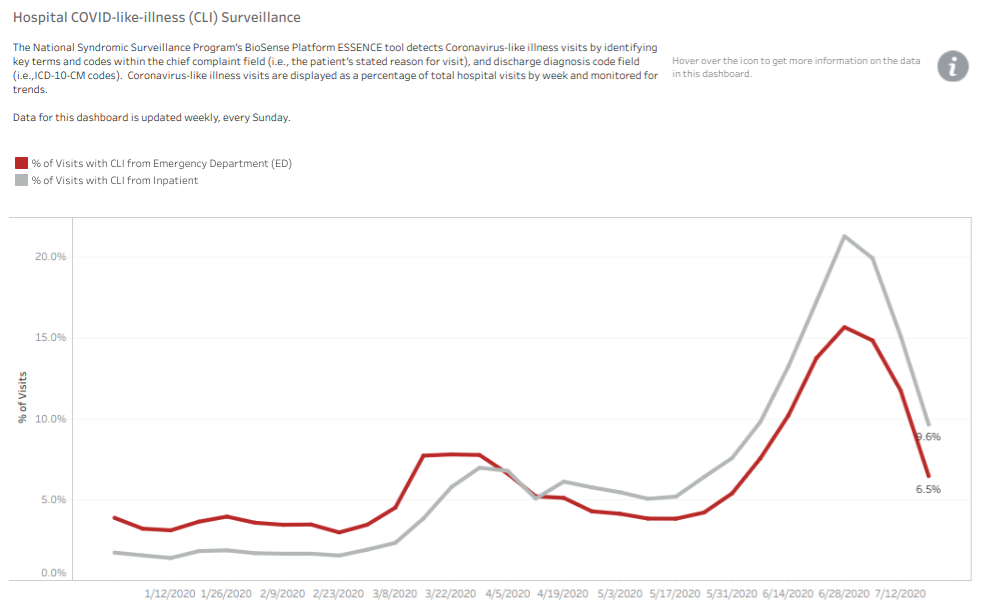
The corona is cancelled, folks.
The riots will need to be dialed back up. They’ve already greatly increased, as of last night. It is a powder keg, and these federal agents are going to end up having to shoot their way out of a situation. I hope you’ve properly prepared for the night when that happens.
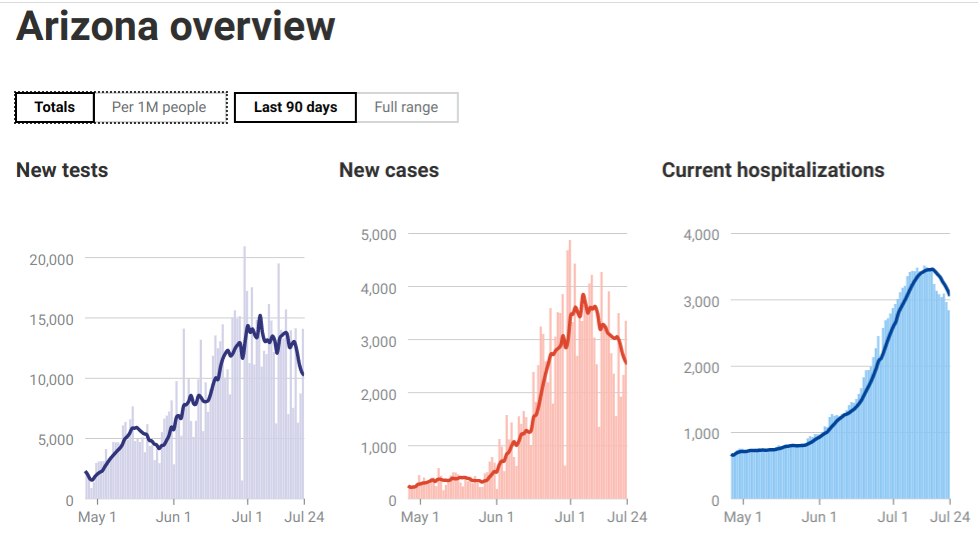
The tests are going down because no one is sick, so no one is getting tested. You can’t even count fake false positives if people don’t want to be tested. The tests are free, and do not require identification. Yet the testing sites are empty.
The red graph in the middle combines positives from PCR tests with serology (antibody) positives. So if you had corona and already recovered, you get counted in that chart anyway. It’s a total joke. But it’s crashing nonetheless.
The blue graph on the right is also about to crash. Here are the hospital discharges per day:
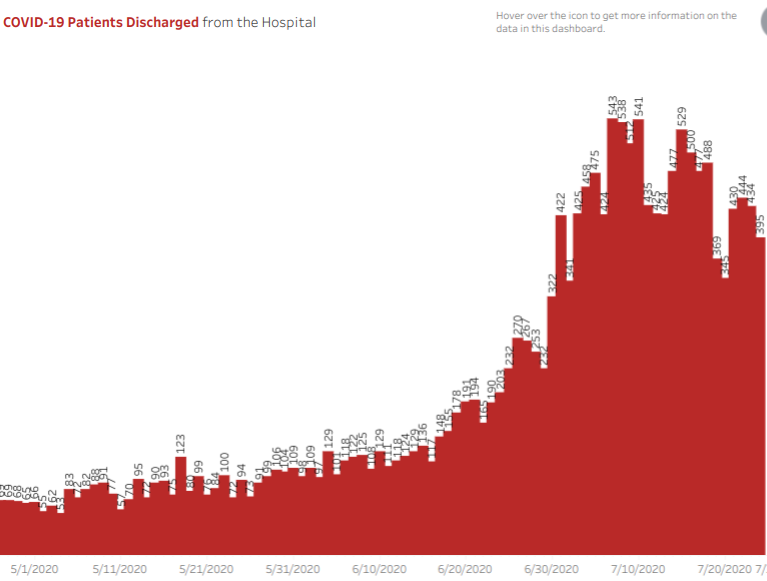
Here are the breakouts. Of 160K total cases, nearly 100K are young people, and almost none of them are sick.
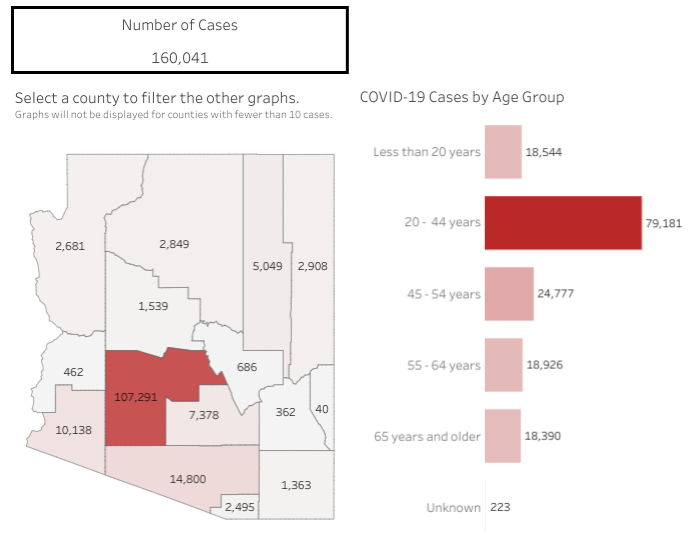
So who are the ones dying? The elderly and those already sick.
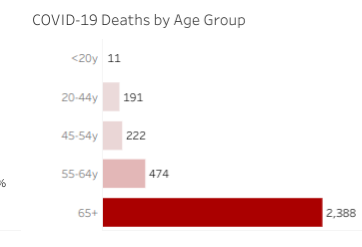
For perspective, our total population is 8MM.
But I am sure all you hear about Arizona is that we are a cesspool of corona.
I have been meaning to revisit my posts from March-April and make an attempt to get those out in the open again, now that many more people are awake. Below is a good place to start. Note towards the bottom, I inserted the description of the exact scenario that they simulated. See if you notice any similarities from the last four months.
Many others have written about this, and it has even reached the MSM to a certain degree. I thought it would be a good idea to just lay out, in their own words, exactly what happened on 18 October 2019, in a ballroom at The Pierre on 5th Avenue in New York. “Event 201” was a War Game, an exercise, a simulation, wherein a Coronavirus pandemic sweeps the world, and governmental responses are planned and executed.
The event was sponsored and conducted by Johns Hopkins and the Gates Foundation, the same outfits now controlling all of the data and policy which have lead to your current non-simulated confinement, and it was heavily attended by the same press which are now enforcing the tyranny.
Everything that follows was copied directly from the Event201 website, unedited. Go ahead and read through this; it gets more interesting the deeper you go. There are several hours-long videos at the site, but I am including here just the 12 minute summary video of the sim, which will sufficiently blow your mind. There is a link at the very end to their website where you can find all of it.
If you manage to make it through this material and conclude that it is all just a wild coincidence, please leave your convincing argument in the combox. Again, everything that follows is cut and pasted directly from their website, unedited.
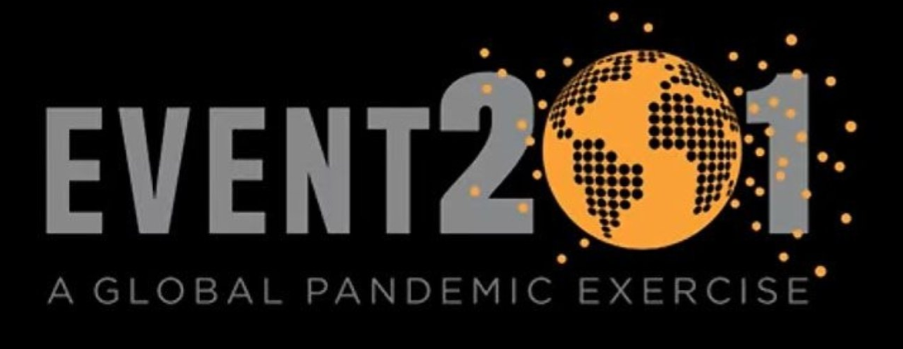
The Johns Hopkins Center for Health Security in partnership with the World Economic Forum and the Bill and Melinda Gates Foundation hosted Event 201, a high-level pandemic exercise on October 18, 2019, in New York, NY. The exercise illustrated areas where public/private partnerships will be necessary during the response to a severe pandemic in order to diminish large-scale economic and societal consequences.
In recent years, the world has seen a growing number of epidemic events, amounting to approximately 200 events annually. These events are increasing, and they are disruptive to health, economies, and society. Managing these events already strains global capacity, even absent a pandemic threat. Experts agree that it is only a matter of time before one of these epidemics becomes global—a pandemic with potentially catastrophic consequences. A severe pandemic, which becomes “Event 201,” would require reliable cooperation among several industries, national governments, and key international institutions.

Thank you to members of the press that attended Event 201. There are opportunities for those that missed it to view a video of the exercise online now, and to use materials posted on this page to share the insights of leaders of business and industry, governments, and global health about why pandemic preparedness collaboration among private businesses with the public sector is so critically important at this time.
The next severe pandemic will not only cause great illness and loss of life but could also trigger major cascading economic and societal consequences that could contribute greatly to global impact and suffering. Efforts to prevent such consequences or respond to them as they unfold will require unprecedented levels of collaboration between governments, international organizations, and the private sector. There have been important efforts to engage the private sector in epidemic and outbreak preparedness at the national or regional level.1,2 However, there are major unmet global vulnerabilities and international system challenges posed by pandemics that will require new robust forms of public-private cooperation to address.
(Edit: Read the whole list at the website. I found this point most interesting):
Governments and the private sector should assign a greater priority to developing methods to combat mis- and disinformation prior to the next pandemic response. Governments will need to partner with traditional and social media companies to research and develop nimble approaches to countering misinformation. This will require developing the ability to flood media with fast, accurate, and consistent information. Public health authorities should work with private employers and trusted community leaders such as faith leaders, to promulgate factual information to employees and citizens. Trusted, influential private-sector employers should create the capacity to readily and reliably augment public messaging, manage rumors and misinformation, and amplify credible information to support emergency public communications. National public health agencies should work in close collaboration with WHO to create the capability to rapidly develop and release consistent health messages. For their part, media companies should commit to ensuring that authoritative messages are prioritized and that false messages are suppressed including though the use of technology.
Accomplishing the above goals will require collaboration among governments, international organizations and global business. If these recommendations are robustly pursued, major progress can be made to diminish the potential impact and consequences of pandemics. We call on leaders in global business, international organizations, and national governments to launch an ambitious effort to work together to build a world better prepared for a severe pandemic.
Event 201 simulates an outbreak of a novel zoonotic coronavirus transmitted from bats to pigs to people that eventually becomes efficiently transmissible from person to person, leading to a severe pandemic. The pathogen and the disease it causes are modeled largely on SARS, but it is more transmissible in the community setting by people with mild symptoms.
The disease starts in pig farms in Brazil, quietly and slowly at first, but then it starts to spread more rapidly in healthcare settings. When it starts to spread efficiently from person to person in the low-income, densely packed neighborhoods of some of the megacities in South America, the epidemic explodes. It is first exported by air travel to Portugal, the United States, and China and then to many other countries. Although at first some countries are able to control it, it continues to spread and be reintroduced, and eventually no country can maintain control.
There is no possibility of a vaccine being available in the first year. There is a fictional antiviral drug that can help the sick but not significantly limit spread of the disease.
Since the whole human population is susceptible, during the initial months of the pandemic, the cumulative number of cases increases exponentially, doubling every week. And as the cases and deaths accumulate, the economic and societal consequences become increasingly severe.
The scenario ends at the 18-month point, with 65 million deaths. The pandemic is beginning to slow due to the decreasing number of susceptible people. The pandemic will continue at some rate until there is an effective vaccine or until 80-90 % of the global population has been exposed. From that point on, it is likely to be an endemic childhood disease.
Selected moments from the October 18th Event 201 Exercise (Length: ~12 minutes; worth your time)